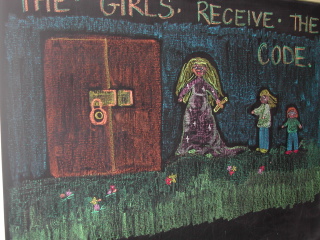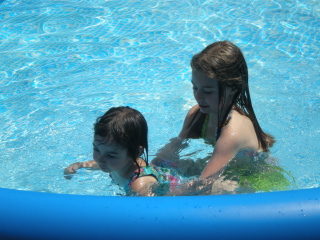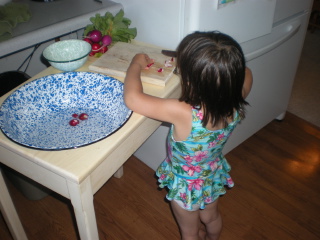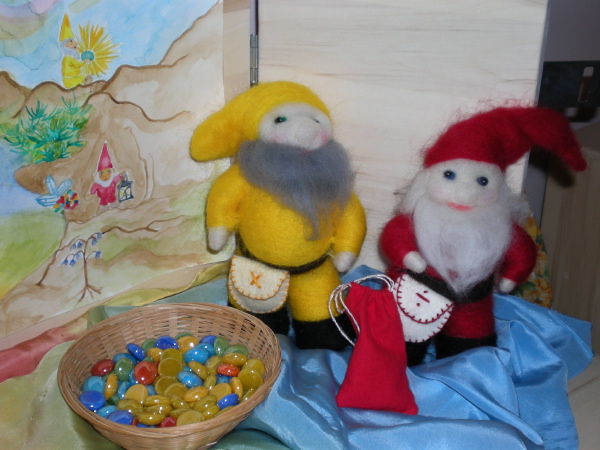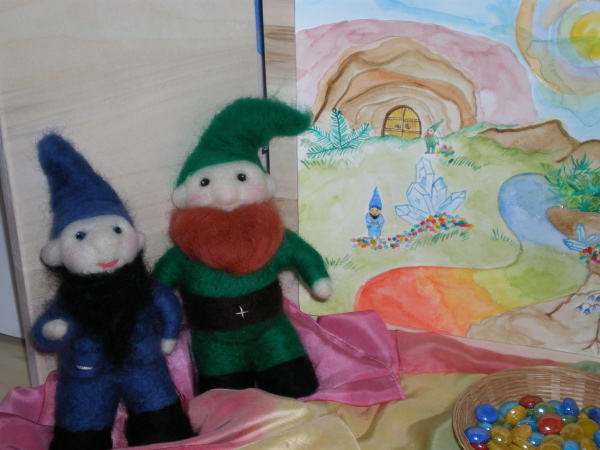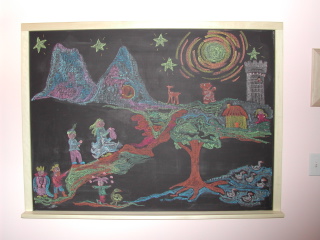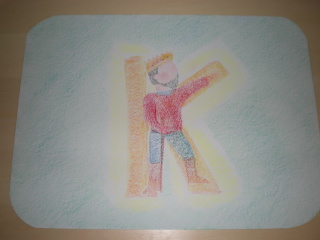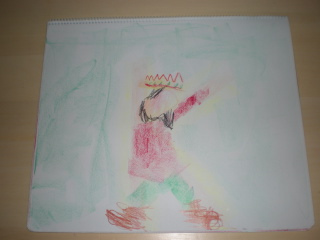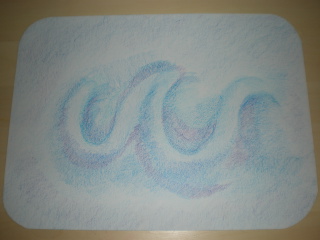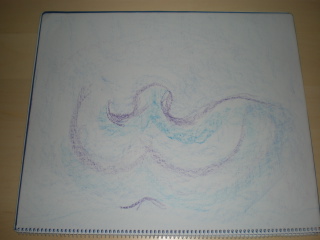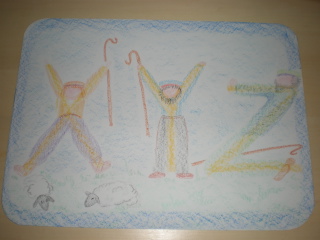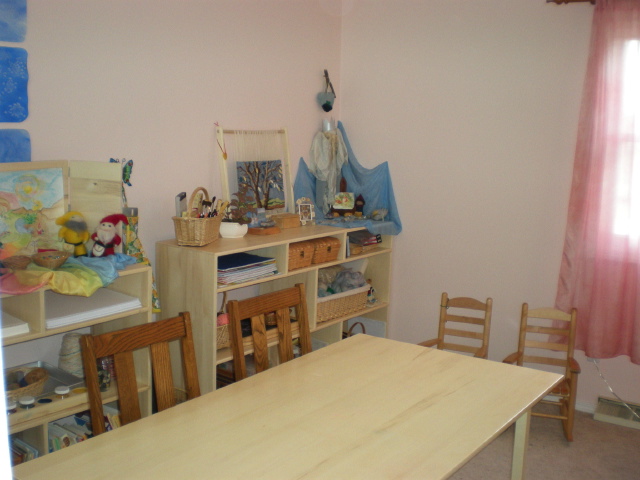And there it is, in a nutshell . . . one of the reasons why, in my opinion, the Waldorf approach stands apart from all other educational methods. The first formal lesson a child receives regarding the complex world of mathematics — the Quality of Numbers. In this lesson the numbers one through twelve are presented to the first grade student, not just as abstract signs representing a quantity, but as symbols with an essential identifying nature, a quality. For example, the number ‘one’ is presented along with its quality of wholeness, unity, individuality, ‘two’ with its relationship to duality, as well as to the concept of opposites, and so on.
As I presented this main lesson block to Starling, I witnessed for the first time what I had read about regarding the importance of teaching to a child’s feeling life. Steiner said in a lecture devoted to the teaching of Arithmetic, “It is essential that you have some understanding of the real essence of every subject that you teach, so that you do not use things in your teaching that are remote from life itself.” It quickly became apparent that abstract explanations would be ineffective. Try explaining the concept of a “unit” to a first grader. It’s rather difficult. Instead, it is much more useful to say, “One is the sun!” and then to stand back and watch the child come to an understanding of the number one through their own life experience, through a soul connection.
As I was planning out the details of this main lesson block, I kept coming up disappointed. By this time, I had accumulated a few new curriculum resources, but it seemed that every one of them was lacking in substance when it came to this important block. We had just finished an exciting three week block on capital letters and I was really hoping for the same kind of rich story line to carry us through the next three weeks. That’s when I discovered Marsha Johnson’s yahoo group waldorfhomeeducators and the amazing archive of files she has created (free of charge, I might add). Adapting Marsha’s idea about a journey to the Land of Numeria, I wrote a three-week block designed to capture the imaginations of my two girls. I choose two characters, sisters, who I named Phaedra (‘bright’ for Starling) and Adira (‘mighty’ for Chickadee). Here is the beginning of their adventure:
Once upon a time in a land not far from our own, there lived two sisters, Phaedra and Adira. Much like the two of you, these two sisters liked to spend their time together. They played together and ate together and slept in the same bed under a thick warm blanket. On beautiful autumn afternoons they would take long walks, exploring little worlds that existed under the rotting logs and leaves. They would watch the activities of the ants and the beetles readying themselves for the long winter ahead. One such afternoon as the two girls walked through a sun-lit meadow, quietly listening for the rustle of animals, they heard a crunching sound just a short way off in the distance. “Ssh,” said Phaedra, “let’s walk as silently as we can and see if we can spy the tiny creature that is making that noise.” The two girls walked slowly and silently and looked for signs of movement. Under a fir tree, not far from where they stood, they spotted a brown rabbit, busily munching on a green leaf. He seemed not to notice them, but as they moved closer the observant rabbit froze with caution. Phaedra and Adira made another step toward the rabbit and as they did, up he sprang, bounding away through the tall grass, his white tail flashing as he ran. The girls ran after him and as quick as a whip the rabbit darted under a large stone and disappeared. Phaedra and Adira followed after him and when they came to the stone, they knelt down. Each girl wanted to look under the stone first. When they lifted the stone they found a large hole. “Phaedra, let me look!” said Adira, as she tried to peer deeper into the hole. And as she did so, she toppled over the edge of the hole and fell in. Phaedra reached for her sister’s shirt in order to save her from the fall, but despite her most strident efforts, she could not grab her sister and she too began to tumble. Down, down they fell until they both landed with a thump on the soft ground. And suddenly, it was as if someone had turned out the lights. The sun-filled meadow was gone and in its place the girls found themselves in a dim and unfamiliar world. All around them the flat grey landscape stretched for miles. In the distance they could see nothing but a single hill rising from the flat land, illuminated by a bright white moon. The two girls looked at each other in amazement. They were not afraid, after all they had each other, and there was something peaceful, albeit strange about this new world. Adira reached out her hand and helped her sister up from the ground. Then the two sisters brushed themselves off and without saying a word started walking toward the distant hill. They travelled over the landscape, enjoying the view of the large moon, and resting once in a while. At sunrise, in the pink and gold light of early morning, they came to the hill. Rising up the slope in front of them was a long series of steps, which the girls immediately began to climb. Something was urging them onward. It took many minutes for Phaedra and Adira to reach the top of the hill, each sister pausing to help the other. At the top of the mound they came to a large wooden door that was held shut by a heavy metal padlock. Phaedra looked at Adira. Now what would they do? Just then, as if out of the mist, a woman appeared before them. She was dressed in long billowing robes, that sparkled in the light but had no color.
“Welcome” the mysterious woman said. “My name is Cipher and I am the guardian of the land that lies beyond this door.”
“Hello” said Phaedra, “My sister and I are lost. Could you tell us please how we can open this door? We are hoping to find our way home.”
“The only way through this portal is to answer twelve ancient questions.” said Cipher.
“Twelve questions.” said Adira. “We can do that.”
“Each question will be put forth in turn and must be answered by sunrise of the following day.”
“O.K.,” said Phaedra, “What is the first?” and she looked at the lovely woman in the glistening garments.
“The first question is: What is ONE?” and as she posed the question, the lady in the gossamer gown disappeared before their eyes.
The two sisters sat down to ponder the question.
Propped on a chair next to our story chair was a set of “doors” that my husband had built for me the week before. They were closed with a latch and padlock. My idea was that Starling and Chickadee could discover what was “behind the closed doors” just as Phaedra and Adira would do in the story. What I didn’t anticipate was Starling’s initial desperation to open the doors right away. She worked to open the padlock for at least an hour. When that didn’t work, she tried to pry the doors open. Finally, near tears, she said to me, “Please tell me how to open the doors!” I was a little nervous that my attempt to recreate the mystery of the story for Starling was going to backfire. How would she last for three weeks until all the questions were answered? I simply said, “You’ll find the answer. Give it time.” She kept prying. . . .
Sometimes, quite unexpectedly, we find ourselves teaching our children lessons that we had not planned for. It’s very satisfying I think, when life lessons and “school” lessons coincide.
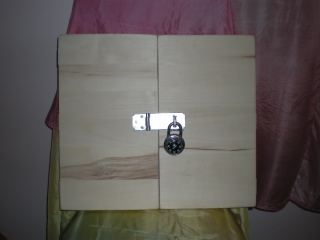
The next day Starling had resigned herself to being patient; she and I recalled the introduction together. I asked her if she had thought about the question that was posed to Phaedra and Adira and if she had any ideas about the answer. The concept of number quality was not discussed directly, so I received answers like “Well we have one table.” or “There is one window in our room.” We continued on like that for a few minutes and then I said, “Let’s see what Phaedra and Adira have come up with.” Here is the continuation of the story into the second day:
The girls were eager to discuss Cipher’s question with each other.
“What is ONE?” said Phaedra “What could the answer be?”
“Well,” said Adira “One is the least of all the numbers. No number is smaller than one. Numbers get bigger and bigger. Even two is greater than one.”
But Phaedra had a different thought. “But isn’t it true that all the numbers are made from one. To get to two we add one to one, then to go on to three we add another one. Every number is one more than the one before it.”
“In this way,” said Phaedra “One may seem like the smallest number, but in so many ways it shows us that it is the greatest of the numbers!”
“And think of this,” said Phaedra. If we have one loaf of bread, and we divide it in half we can make two. If we cut those two pieces in half, we end up with four. We can go on and on in this manner for a long time. When we considered it in this way, all numbers can be contained within one!”
“Yes! Yes!” Adira joined in. “When I think of one I think of the sun. The sun is one! But hundreds of rays come out of the sun. When we were in the sun-filled meadow, I felt the sun’s rays. Sometimes I feel as if the sun sends one special ray just to warm me.”
Phaedra smiled, “Yes, I’ve felt that way too! I like to think that each of us carries our own beautiful ray of light, because each one of us is so different and special. Yet all together we are one people – one humanity”
“Yes,” Adira said, feeling her own special light, “One world!”
And then, as she was known to do, Phaedra made up a verse on the spot:
One is the sun, one is the sky,
One is the world, one am I.
“But how shall we answer Cipher’s question?” said Adira “One can be so many things.”
“Let us sleep on it. Perhaps we will know in the morning.” said Phaedra
The two girls layed down on the soft ground and quickly fell asleep. In the morning they awoke feeling refreshed. They were surprised to find a simple breakfast laid out for them. When they finished eating, the beautiful woman appeared to them again.
“So my dear girls, are you ready to answer my first question?” Cipher said.
“Well,” said Phaedra “Adira and I discussed it last night,” “But we have come up with so many answers. We do not know which one is correct.”
“Tell me what you have discovered during the course of your discussion.”
The girls told Cipher what they had determined. One is the sun, it is the world, it is man. One is the whole. It is the individual. It is unity.
Cipher looked pleased. “Yes,” she said “One is all these things. I was not looking for only ONE answer.” She said with a chuckle.
Then Cipher looked at Phaedra and Adira and said, “The time has come for you to learn the first secret symbol that will help to unlock the door.” The lovely woman knelt down and began to rub some of the sandy dirt away in front of her and there, in the rock were two forms. [1, I]
“Record these in your memory” said Cipher “They will help you on your journey.”
“Now,” she said “Are you ready for the second ancient question?”
“Yes!” the girls exclaimed eagerly.
“The second question is: What is TWO? I will return again at sunrise” and as she finished speaking Cipher disappeared, leaving the two girls to another day of thought and discussion.
For the second day’s story and all the days after that, I relied heavily on Live Education. It was very useful in offering ideas related to each number. I also incorporated Marsha Johnson’s idea of the wise woman revealing the symbols related to each number. Such great imagery!
After the story, on the second day, we started a series of drawings in a new main lesson book. Starling decided to draw a sun. I drew it on the blackboard and she used my drawing as a guide for her own. On the opposite page she wrote the word ONE, the number itself, and the Roman numeral. And so it went every day until all twelve ancient questions were asked. Here’s the rest of the story.
Very long story short . . .
Three weeks later, the twelfth question was answered, and Phaedra and Adira received a golden scroll from Cipher. I handed Starling a “golden scroll” wherein were written the words, which I helped her to read:
To open the door to the Land of Numeria, first turn to the right III times. Stop at the number IX. Turn left one full turn, passing the first number to stop at the number XXIII. Then turn right and stop at the number V. Pull the shackle.
Starling had to translate the Roman numerals into Arabic in order to dicipher the code. It was so exciting; and what a reaction when the doors opened to reveal the Land of Numeria! It was priceless.
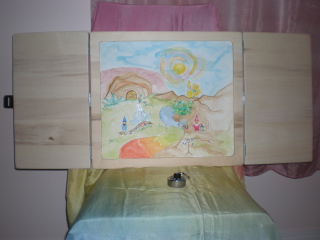
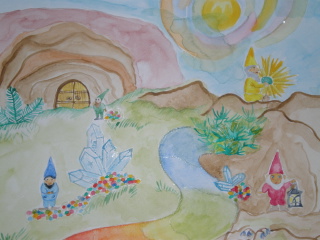
The girls (all of them!) had received the code! We made a final drawing to celebrate.

